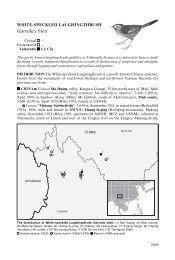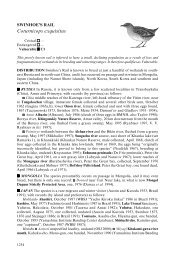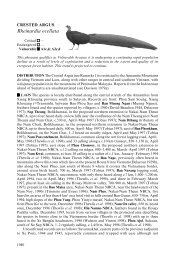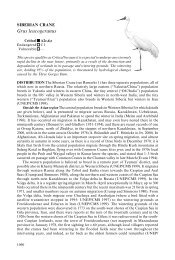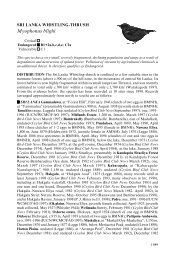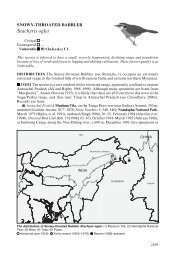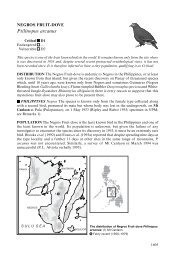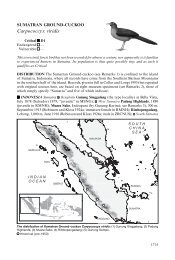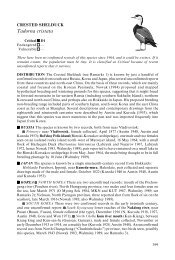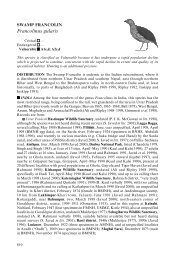Amandava formosa - BirdBase
Amandava formosa - BirdBase
Amandava formosa - BirdBase
You also want an ePaper? Increase the reach of your titles
YUMPU automatically turns print PDFs into web optimized ePapers that Google loves.
Threatened birds of Asia<br />
GREEN AVADAVAT<br />
<strong>Amandava</strong> <strong>formosa</strong><br />
Critical —<br />
Endangered —<br />
Vulnerable A1a,c,d; A2b,c,d<br />
This colourful finch qualifies for Vulnerable because it has a rapidly declining population owing<br />
to widespread trapping for the cagebird trade, compounded by habitat loss and degradation<br />
through agricultural intensification.<br />
DISTRIBUTION The Green Avadavat (see Remarks 1) is endemic to India where it is<br />
distributed locally from southern Rajasthan, central Uttar Pradesh and southern Bihar to<br />
northern Andhra Pradesh and (possibly) northern Kerala (Grimmett et al. 1998; also Sharma<br />
and Tehsin 1994). There are also recent records from north and east Rajasthan. Early records<br />
from around Lahore, Pakistan (4–5 nests in ornamental trees in a municipal garden, now<br />
known as Bagh-I-Jinnah), suggested that it was “one of those species which is only found<br />
there during the monsoon” (Currie 1916a,c); it has not been found again and the birds in<br />
question were probably escaped cagebirds (Whistler ms, Roberts 1991–1992, Grimmett et<br />
al. 1998). Although West Bengal is sometimes mentioned as part of the range of this species<br />
(e.g. Goodwin 1982), there are no confirmed records from this state (see Grimmett et al.<br />
1998). Records are from:<br />
■ INDIA ■ Rajasthan Taal Chappar Wildlife Sanctuary, Churu district, March 1991 (Rahmani<br />
1996c); between Sultanpur jheel, Haryana, and Keoladeo National Park, Bharatpur, closer<br />
to the latter and thus probably in the region of Deeg, one amongst a flock of Red Avadavat<br />
<strong>Amandava</strong> amandava, February 1978 (B. F. King verbally 1998; although see Remarks 2);<br />
Desert National Park, in Sudasari enclosure, one, July 1993 (Rahmani 1996c); Kumbhalgarh,<br />
undated (R. Singh per K. Kazmierczak in litt. 1999), 10–15, January 1999 (A. Prasad in litt.<br />
1999); Mount Abu, Sirohi district, listed by Devarshi and Trigunayat (1989), with records in<br />
March and July 1868, and May 1875 (three specimens in BMNH, Butler 1875–1877), at Oria<br />
(Oriya) in January 1949 (specimen in FMNH), and two there in 1993–1994 (Prakash and<br />
Singh 1995), with several flocks of 3–6 including in the Salgaon area, Adhar Devi temple<br />
forest and at Kanyakumari temple, October 1996 (Tiwari and Varu 1999), one, November<br />
1997, and at least two, October 1998 (Lodhiya 1999);<br />
■ Gujarat Gangasagar, Palanpur, January 1946 (Ali 1954–1955); Taranga hill, Mehsana<br />
district, nine, May 1996 (Tiwari and Varu 1999); Vadodara (Baroda), undated (Littledale<br />
1886), and again in June 1999 when a pair were seen near the Mayo Hospital (Mukherjee<br />
and Borad 2000); found at Rajpipla, Bharuch district, along the Mozda river, Samot road,<br />
and once near Moti-Singloti, several kilometres from Mozda towards Dediapada, March<br />
1946 (four specimens in USNM, Ali 1954–1955, Monga and Naoroji 1984);<br />
■ Uttar Pradesh around Lucknow, undated (Blyth 1866–1867, Reid 1881), these records<br />
leading to the mention of “Oudh” (Avadh) as part of the species’s range (A. O. Hume in<br />
Butler 1875–1876); Jhansi, September 1860, August 1868 and undated (10 specimens in<br />
BMNH and USNM, A. O. Hume in Butler 1875–1876);<br />
■ Madhya Pradesh unspecified localities in the Satpura hills (not mapped), undated (Ball<br />
1874), and “Satpur, Khandesh” (presumably the Satpura hills), April 1884 (specimen in<br />
BMNH); Orchha, east of the Betwa river, 12, August 1993, seven, September 1997, but none<br />
in January 1999 (Saxena 1999); Tikamgarh, 60–70, June 1994 (Ahmed 1998, Bhargava 1996);<br />
Guna (Goona), undated (King 1868); Sagar (Saugor), July 1869 (specimen in BMNH), a<br />
2334
<strong>Amandava</strong> <strong>formosa</strong><br />
nest with two eggs in June 1903 (BMNH egg data), undated (Moss King 1911); Sehore,<br />
resident (Whitehead 1911); Surguja (Sirguja), undated (Ball 1874, 1878; also Ali and Ripley<br />
1968–1998); Dodi, Malwa plateau, 500 m, January 1938 (Ali and Whistler 1939–1940, specimen<br />
in BMNH); Mandla district (Mundlah), April 1869 (two specimens in BMNH); Amarkantak<br />
(Omerkántak), near the source of the Narbada river, where “it occurs very abundantly”,<br />
undated (Blyth 1866–1867), with records from unspecified localities in the upper Narbada<br />
valley (Ball 1874); Mhow, particularly in the Vindhya range nearby, undated (Jerdon 1862–<br />
1864), with specimens later purchased at Mhow, undated (Swinhoe and Barnes 1885), and<br />
“a few” seen south of Mhow, near Killod, June 1928 (Briggs 1931); Pachmarhi, undated<br />
(Jerdon 1862–1864, Whistler ms), and one, early 1995 (A. K. Nagar per K. Kazmierczak in<br />
litt. 1999); Korba, Bilaspur district, undated (Jerdon 1862–1864), April 1870 (two specimens<br />
in BMNH), and thus listed for Bilaspur district by Ball (1878); Kanha National Park, 600 m,<br />
one male at Chuhari nala (Churi nullah), September 1972 (Güntert and Homberger 1973;<br />
also Newton et al. 1987), and “a flock” in December 1995 in the meadows of Bithli, Piparwada,<br />
Chilpura and Supkhar (Kanoje 1996b); Seoni, where seen on “high land” nearby, undated<br />
(Jerdon 1862–1864); Balaghat district, January 1912 (D’Abreu 1912); Betul district, seen only<br />
1<br />
NEPAL<br />
2<br />
UTTAR PRADESH<br />
3<br />
RAJASTHAN<br />
10<br />
5<br />
4<br />
INDIA<br />
14<br />
11<br />
12<br />
13<br />
BIHAR<br />
6<br />
GUJARAT<br />
7<br />
8<br />
9<br />
31 30<br />
32<br />
34<br />
37<br />
21<br />
18<br />
16<br />
33<br />
27<br />
15<br />
MADHYA PRADESH<br />
19<br />
22<br />
24<br />
25<br />
26<br />
36 35<br />
38<br />
20<br />
28<br />
23<br />
17<br />
46<br />
47<br />
ORISSA<br />
39<br />
MAHARASHTRA<br />
41<br />
43<br />
40<br />
29<br />
48<br />
49<br />
A R A B I A N<br />
S E A<br />
42<br />
ANDHRA PRADESH<br />
45<br />
44<br />
The distribution of Green Avadavat <strong>Amandava</strong> <strong>formosa</strong>: (1) Churu district; (2) Deeg; (3) Desert National<br />
Park; (4) Kumbhalgarh; (5) Mount Abu; (6) Gangasagar; (7) Taranga hill; (8) Vadodara; (9) Rajpipla; (10) Lucknow;<br />
(11) Jhansi; (12) Orchha; (13) Tikamgarh; (14) Guna; (15) Sagar; (16) Sehore; (17) Surguja; (18) Dodi; (19) Mandla<br />
district; (20) Amarkantak; (21) Mhow; (22) Pachmarhi; (23) Korba; (24) Kanha National Park; (25) Seoni;<br />
(26) Balaghat district; (27) Betul district; (28) Raipur; (29) Bastar district; (30) Toranmal; (31) Dhadgaon;<br />
(32) Taloda; (33) Melghat Sanctuary; (34) Nandurbar; (35) Bhandara; (36) Nagpur; (37) Dhule; (38) Wardha;<br />
(39) Tansa lake; (40) Ahiri; (41) Pimpalner; (42) Mahabaleshwar; (43) Utnur; (44) Sankrametta; (45) Sileru;<br />
(46) Palamau National Park; (47) Lohardaga; (48) Koraput district; (49) Jaypur.<br />
Historical (pre-1950) Fairly recent (1950–1979) Recent (1980–present) Undated<br />
2335
Threatened birds of Asia<br />
once in the Satpura range near the Nimar border, undated but presumably 1930s (Hewetson<br />
1940); Raipur, January 1871 (Ball 1878, five specimens in BMNH); Bhanpur (Bhanpuri),<br />
Bastar district (Old Bastar), undated (Whistler and Kinnear 1931–1937);<br />
■ Maharashtra “Konkan”, undated (E. A. Butler 1881), a region too vague to map, but<br />
with records apparently “on the one border and on the other border” (Ali and Whistler<br />
1933–1934); Toranmal, June 1988–June 1990 (Vyawahare 1991); Dhadgaon, June 1988–June<br />
1990 (Vyawahare 1991); by the Tapti river, north-west of Taloda, “considerable flocks of<br />
what I have no doubt was this species”, April, 1879–1881 (E. A. Butler 1881), and an<br />
unspecified locality in the “Tapti valley”, May 1874 (one in BMNH); Melghat Sanctuary,<br />
Kolkaz, Amravati district, 570 m, February 1976 (specimen in USNM, Sawarkar 1987),<br />
specifically at Semadoh on the road to Chikhaldara, undated, and at Chikhaldara (Chikalda),<br />
groups of seven and 10, March 1995 (K. Kazmierczak in litt. 1999); west of Nandurbar, a<br />
small flock of “what I have no doubt was this bird”, May 1881 (Davidson 1882); Bhandara,<br />
a nest in July 1874 (Hume and Oates 1889–1890, BMNH egg data); Nagpur, undated (D’Abreu<br />
1935, Whistler ms); Dhule, undated (Vyawahare 1991); east of Wardha in the Wardha valley,<br />
undated (Blanford 1871); Tansa lake, Bombay area, party of four, September 1943 (Ali and<br />
Abdulali 1945b); on the Pranhita river, near Ahiri, April 1867, April 1874 (Blanford 1869,<br />
Ali and Whistler 1933–1934, two specimens in BMNH), and in the Chanda forest, presumably<br />
near Chandrapur (Chanda) (not mapped, but between Wardha and Ahiri), undated (Blanford<br />
1869); “Khanapur Sarai”, Pimpalner, March 1884 (three specimens in BMNH); near<br />
Mahabaleshwar, undated (Fairbank 1876);<br />
■ Andhra Pradesh Utnur (Utnoor), Adilabad district, on the basis of a reliable local report,<br />
undated (Ali and Whistler 1933–1934); Sankrametta, Vizagapatam (Vishakhapatnam) district,<br />
900 m, six collected, March 1930 (Whistler and Kinnear 1931–1937), also in Vizagapatan<br />
district at Lamasinghi, 1944 (Abdulali 1945); Sapparla, 32 km east of Sileru, Vizagapatam<br />
district, female, March 1975 (Ripley et al. 1988; also Ali and Ripley 1968–1998);<br />
■ Bihar Palamau district, presumably in what is now Palamau National Park, April 1878<br />
(one in BMNH); unspecified locality, pre-1845 (two specimens in BMNH); Lohardaga<br />
(Lohardugga), undated (Ball 1878);<br />
■ Orissa Koraput district, “not very common”, undated (Majumdar 1988); Jaypur (Jeypore<br />
Agency), 900 m, two collected, April 1930 (Whistler and Kinnear 1931–1937).<br />
The following are unconfirmed records. A bird at Sunder Nagar, beside Delhi Zoo, in<br />
October 1978 (Gaston and Mackrell 1980) is thought likely to have been an escape from<br />
captivity (T. P. Inskipp in litt. 1999). A possible flock was seen at Badarwas, March 1938<br />
(Ali and Whistler 1939–1940, Ali ms). Claims of “small parties” of 3–6 on footpaths and<br />
open hillsides in October, November and early December 1990 in northern Kerala<br />
(Neelakantan et al. 1993), and of a “flock” seen in northern Karnataka (at Anshi National<br />
Park) in 1994 (Uttangi 1994b), would represent previously undiscovered populations or<br />
perhaps post-breeding dispersal if they are confirmed (T. P. Inskipp in litt. 1999). Further<br />
sightings of around seven individuals at Thattakad Bird Sanctuary in the 1990s again suggest<br />
that a small and local population exists in Kerala, perhaps consisting of escapees from captivity<br />
(Sugathan and Vargese 1996; but see Santharam 2000).<br />
POPULATION The global population of the Green Avadavat appears to be centred on<br />
Madhya Pradesh, where early reports gave it variously as “uncommon and sporadic” (Ali<br />
and Whistler 1939–1940), “fairly common in some parts” (Baker 1932–1935), “by no means<br />
rare” in the Satpura hills and the Narbada valley (Ball 1874), “common” in various places<br />
(Barnes 1885, Whitehead 1911), and apparently “rather abundant” in the Pachmarhi area<br />
(Jerdon 1862–1864). More recently, flocks of up to 60–70 individuals were seen in 1994 in<br />
the Tikamgarh area (Bhargava 1996), with unspecified numbers in Kanha National Park in<br />
1995 (Kanoje 1996b). Blyth (1866–1867) reported that it “occurs very abundantly” at<br />
2336
<strong>Amandava</strong> <strong>formosa</strong><br />
Amarkantak, around the source of the Narbada river, while Ball (1874) stated that it occurred<br />
in Surguja, “if not in other parts of Chota Nagpur”. The general impression is that it has a<br />
“very erratic distribution but where it occurs it is abundant” (Hewetson 1956).<br />
In surrounding states it is usually found to be less common, although it occasionally occurs<br />
in large numbers. For example, in Andhra Pradesh it was thought “common” at Sankrametta<br />
(Whistler and Kinnear 1931–1937), and “small parties” of 4–8 were seen by Price (1980). None<br />
was recorded, however, during the Hyderabad State Survey apart from local reports at Utnur<br />
(Ali and Whistler 1933–1934). In Gujarat it is scarce; Ali (1954–1955) thought it “locally and<br />
capriciously distributed … in flocks of 20 or so”, while Monga and Naoroji (1984) encountered<br />
small groups on three occasions. In Maharashtra it has been described as “rather scarce” in<br />
general (Blanford 1869), “very local” in the Wardha valley (Blanford 1871), “not common” in<br />
the “Konkan” region (E. A. Butler 1881), “rare” near Mahabaleshwar (Fairbank 1876),<br />
occurring in “considerable flocks” in the Tapti valley (Davidson 1882), and more recently<br />
“common” at Melghat Sanctuary (Sawarkar 1987). In Orissa it was thought “not very common”<br />
(Majumdar 1988). On and around Mount Abu, Rajasthan, however, it has apparently always<br />
been relatively “common” (Butler 1875–1876), and this also seems to be the case in Udaipur<br />
district (Banerjee 1996). In Uttar Pradesh it was uncommon around Lucknow (Reid 1881,<br />
Jesse 1902–1903), occurring “much less plentifully” than the Red Avadavat (Blyth 1866–1867).<br />
The recent records of 2,000 for sale at Ranchi, Bihar, does not imply a large population in this<br />
region as trapping activities are focused on Orissa and Madhya Pradesh (Ahmed 1997, 1998).<br />
Although recent observations have tended to imply small numbers of individuals,<br />
erratically distributed and widely scattered, the occurrence in trade of a minimum of several<br />
thousand birds in the early 1990s (Ahmed 1998) indicates that sizeable populations must still<br />
occur locally. They must be presumed to be declining owing to the pressure of trade, and<br />
indeed trappers report that it is becoming more difficult to catch in many areas (Ahmed<br />
1997). It has been suggested that populations in “many areas of Madhya Pradesh have already<br />
disappeared” (Ahmed 1998). However, direct evidence that the species is declining is lacking<br />
(T. P. Inskipp in litt. 2000) and further investigation is urgently needed to establish some<br />
quantified and comparable baseline population data.<br />
ECOLOGY Habitat The species has been found in low grass and bushes, tall grassland,<br />
sugarcane fields, mango orchards, high trees and boulder-strewn scrub (Reid 1881, Whistler<br />
and Kinnear 1931–1937, Ali and Ripley 1968–1998, Bhargava 1996). On Mount Abu and at<br />
Melghat Sanctuary it has been observed in introduced lantana Lantana camara scrub (Lodhiya<br />
1999, K. Kazmierczak in litt. 1999). One individual was seen in stony arid wasteland on a tall<br />
Capparis bush in Desert National Park (Rahmani 1996c), and a small population in the<br />
Tikamgarh area inhabited “stony, arid waste land” (Ahmed 1998). Reid (1881) found the<br />
species in a mango orchard and high trees near Lucknow. Tiwari (in prep.) observed it in a<br />
nulla (small stream or valley) near a forest clearing in Rajasthan, and in Andhra Pradesh it<br />
frequented tall grass (Ali and Whistler 1933–1934). Birds tend to spend much time in small<br />
flocks (usually fewer than 10) on the ground or in low bushes (Monga and Naoroji 1984,<br />
Bhargava 1996, Ahmed 1997). A small population of 60–70 birds, observed over three days,<br />
restricted itself to an area of 1 km 2 (Bhargava 1996, Ahmed 1998).<br />
Food It presumably feeds on a variety of small seeds, although the only documented food<br />
plants are grasses (Ali and Ripley 1968–1998). In captivity, however, insects make up the<br />
main food during the chick-rearing stage (Immelmann et al. 1965), and this is possibly the<br />
case in the wild.<br />
Breeding Breeding records are from May to January (Hume and Oates 1889–1890, Ali<br />
and Ripley 1968–1998). The only documented nests have been found in sugarcane plantations<br />
(although birds presumably also breed in rough grassland), one of which near Bhandara<br />
contained seven unfinished and completed nests, prompting the suggestion that breeding is<br />
2337
Threatened birds of Asia<br />
semi-colonial (Hume and Oates 1889–1890). These were globular structures with a short<br />
neck made up of coarse grass, lined with finer grass and situated c.2 m above the ground;<br />
clutches apparently contain 5–6 eggs, usually the former (Hume and Oates 1889–1890, Baker<br />
1932–1935, Ali and Ripley 1968–1998). Both sexes build the nest and incubate the eggs (Hume<br />
and Oates 1889–1890). For further details of breeding behaviour in captivity, see Teschemaker<br />
(1905) and Kunkel (1962).<br />
Migration Its movements are minor and poorly understood, with apparent local influxes<br />
or absences potentially related to rainfall or some other environmental variable (Ali and<br />
Whistler 1933–1934, 1939–1940). In many areas the species appears to be present all year<br />
round: E. A. D’Abreu (in Whistler ms), for example, stated that at Nagpur birds are “always<br />
to be found” in “a patch of long grass growing in a perennial stream”.<br />
THREATS Trade Even in the nineteenth century, the Green Avadavat was popular as a<br />
cagebird, sometimes being brought to market in “considerable numbers” (Jerdon 1862–1864,<br />
Reid 1881). It remains a highly sought-after cagebird in both domestic and international<br />
markets, being sold to aviaries, zoos and private individuals (Ahmed 1997, 1998). It is<br />
captured, usually in nets or funnel traps, in substantial numbers, and up to 2,000–3,000 were<br />
estimated to be illegally traded annually for the pet trade in the 1990s (Ahmed 1997). Nearly<br />
1,000 individuals were observed during market surveys in 1992–1994 (Ahmed 1997). Before<br />
international trade was banned, numbers of this species recorded passing through Heathrow<br />
Airport, UK, fluctuated widely, with none in 1970–1972, but 3,244 in 1975 and 8,520 in 1976<br />
(Inskipp 1975, 1983). Up to a decade after trade was outlawed, around 500 individuals were<br />
still arriving at the same airport illegally (T. P. Inskipp in litt. 1999). Moreover, its occurrence<br />
in the markets of Lucknow (25–50 birds on three counts in 1992–1996), Meerut (750 birds in<br />
September 1993), Patna (30–40 birds in September 1993), Tikamgarh (60 birds in June 1994),<br />
Ambala (30 birds in June 1994), Delhi (150–200 birds in two counts in 1994–1995) and Ranchi<br />
(2,000 birds in June 1995) (Ahmed 1998) suggests that huge numbers are still being taken<br />
from the wild for sale within India. Most trapping is at present conducted by trappers from<br />
Lucknow, Bihar and Calcutta, who sell the birds on to regional dealers, who in turn send<br />
them to major markets (Ahmed 1998). The favoured areas for trapping are apparently around<br />
Raigarh, Bhopal, Indore and Katni in Madhya Pradesh (Ahmed 1998). It apparently took<br />
trappers only two days to “wipe out” a small population (60–70 birds) in the Tikamgarh<br />
area (Ahmed 1998).<br />
Most birds in trade presumably derive from wild populations, as the species breeds poorly<br />
in captivity and is only bred in very small numbers by aviculturists in India (Ahmed 1998,<br />
T. P. Inskipp in litt. 1999). As a further consideration, the species has been found to be<br />
susceptible to stress, with a high mortality among trapped birds observed within the first few<br />
days after capture (Ahmed 1997), and thus the number of individuals trapped must far exceed<br />
those identified in trade. Owing to its relative fearlessness it can be trapped very easily (Ahmed<br />
1997), and as a result of continued trapping, its populations appear to have been wiped out<br />
in certain areas (Bhargava 1996). In general, smuggling of birds from India is still common<br />
(generally through Nepal and Pakistan) (Oriental Bird Club Bull. 27 [1998]: 16–20). Indeed,<br />
the species has been seen on sale recently (1999) in Nepal (A. Prasad in litt. 1999), showing<br />
that international trade laws are still flaunted.<br />
Habitat loss Given the broad range of regenerating and open habitats utilised, the species<br />
is not thought to suffer unduly from habitat loss or modification (T. P. Inskipp in litt. 1998).<br />
However, in some areas cultivation is so intensive (i.e. mustard fields in parts of Rajasthan)<br />
that populations of most passerines have declined significantly (B. F. King verbally 1998).<br />
Given the predominance of agriculture in the Indian landscape it is conceivable that associated<br />
pollution is a threat to the species; the widespread deployment of pesticides in India is outlined<br />
in Threats under White-rumped Vulture Gyps bengalensis.<br />
2338
<strong>Amandava</strong> <strong>formosa</strong><br />
MEASURES TAKEN Control of trade The species appears on CITES Appendix II and is<br />
protected under a 1991 amendment of the Wildlife (Protection) Act of India (1972); national<br />
trade is therefore illegal. Trapping and trade has been banned since around 1981. A<br />
countrywide study on the live bird trade in India was taken up by TRAFFIC-India between<br />
1992 and 1994 (Ahmed 1997) and the impact of trade on the species was assessed.<br />
Protected areas The species has been recorded in Kanha National Park, Desert National<br />
Park, Melghat Sanctuary and Taal Chappar Wildlife Sanctuary, and is reported from Palamau<br />
National Park, Anshi National Park, and the Gurukulam Botanical Sanctuary.<br />
MEASURES PROPOSED As very little is known about this species, a detailed study of its<br />
ecology and the impact of trapping and live bird trade on local populations is required.<br />
Extensive status surveys with the help of trappers with prior knowledge of the area are needed,<br />
but also involving rigorous, repeatable censuses in a wide range of areas so as to build a<br />
baseline dataset from which to gauge future population trends. These censuses should be<br />
repeated at regular intervals and at comparable seasons over a long period into the future.<br />
The species should be put in Schedule I of the Wildlife Protection Act (1972), and, depending<br />
on the first indications from repeat censuses, there may well be a case for it to be moved to<br />
Appendix I of CITES.<br />
The control of trapping itself is one of the primary objectives of any conservation<br />
programme for this species. Stricter enforcement and training of authorities would help curb<br />
this illegal trade (Oriental Bird Club Bull. 27 [1998]: 16–20). However, a sensitive approach<br />
should be taken towards the traditional bird-trappers, many of whom are severely<br />
impoverished: a rehabilitation programme is perhaps required for them, including wherever<br />
possible the provision of alternative livelihoods (Oriental Bird Club Bull. 27 [1998]: 16–20).<br />
As the species’s habitat requirements are rather broad, there is little cause for specific<br />
recommendations until its ecology is better understood. The proposal by Tiwari and Varu<br />
(1999) that lantana scrub clearance should be “carried out on a large scale” is perhaps unduly<br />
hasty considering that the species has been recorded frequenting this very habitat (Lodhiya<br />
1999, K. Kazmierczak in litt. 1999).<br />
REMARKS (1) Although treated as Stictospiza <strong>formosa</strong> by early authors (e.g. Sharpe 1890,<br />
Baker 1922–1930), then Estrilda <strong>formosa</strong> by others (e.g. Ripley 1982), Whistler and Kinnear<br />
(1931–1937) noted that it “seems hardly worth separation from <strong>Amandava</strong>” and it is now<br />
generally placed in this latter genus (Inskipp et al. 1996). In common with its congener the<br />
Red Avadavat A. amandava, this species should therefore be called “avadavat” rather than<br />
“munia” (e.g. Grimmett et al. 1998). (2) Traders often sell female Red Avadavats as this<br />
species by dying them green (Ahmed 1997) and green-dyed Scaly-breasted Munias Lonchura<br />
punctulata have been seen free-flying in Delhi (K. Kazmierczak in litt. 1999). These present<br />
potential identification pitfalls, although genuine Green Avadavats can be distinguished by<br />
the presence of barring on the underparts and the lack of white dotting in the plumage (see,<br />
e.g., Grimmett et al. 1998). In addition, damaged individuals are sometimes sold by traders<br />
as “release birds”, to be freed during ceremonies or at temples, and these possibly sometimes<br />
result in some of the sightings of odd individuals in the Delhi region (Ahmed 1998).<br />
2339



